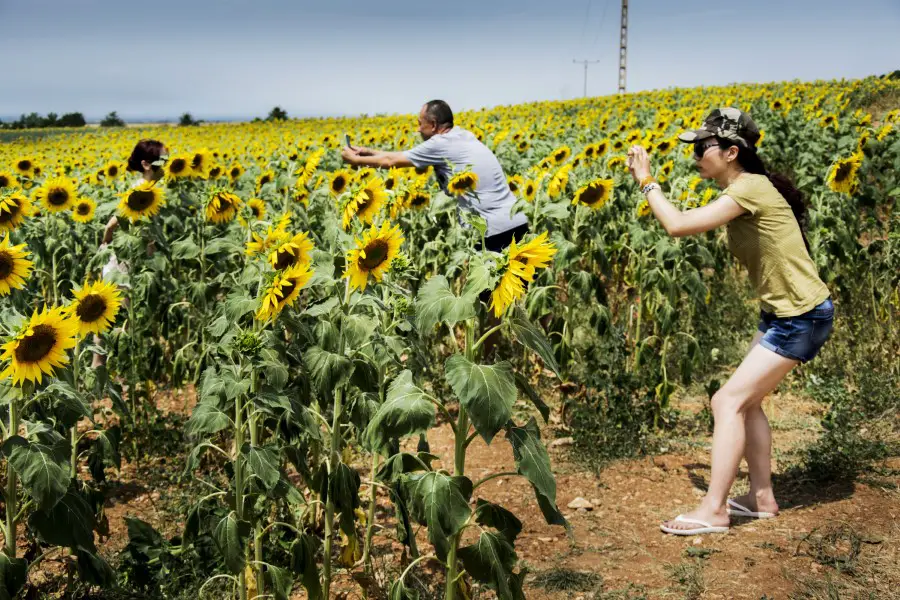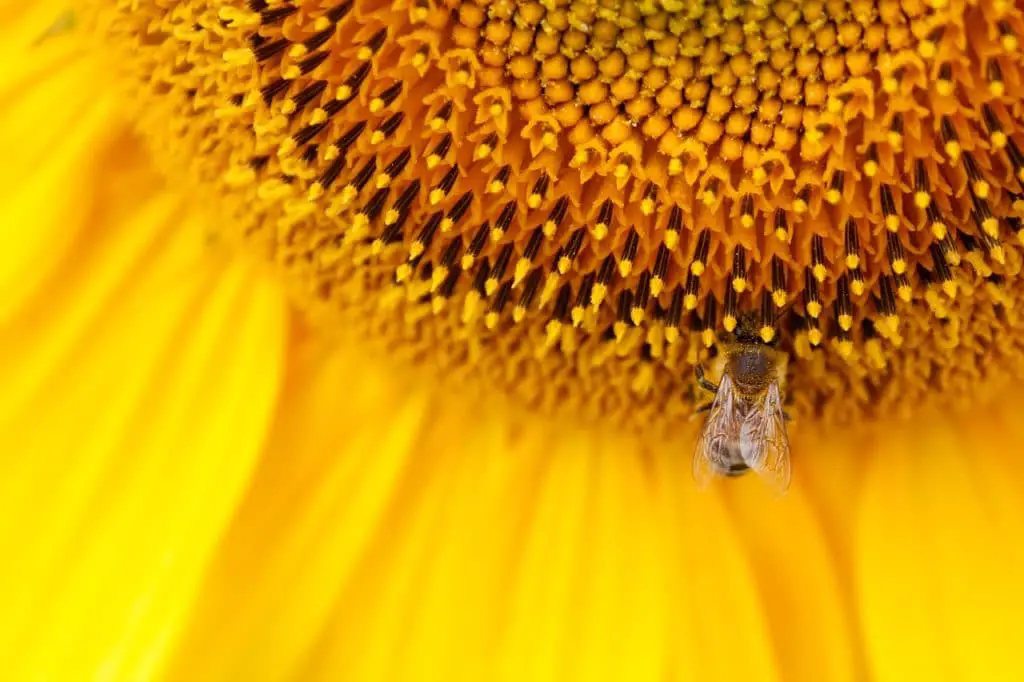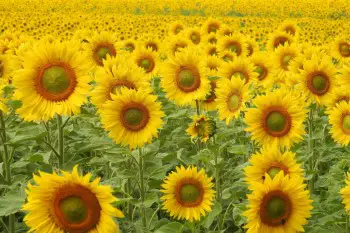When you see a sunflower, you may not realise it has far more about it than many other types of plants. The uses and value it has for us extend far beyond the pretty faced plant most of us instantly recognise.
Of all the plants and flowers in the world, it’s one of the few types that most children learn quite early on and almost everyone recognises and admires.
Allow me to add some sparkle to what you already know about sunflowers, here are the TOP 50 facts about sunflowers that will impress your children next time you decide to grow one in the back yard or pass by a field full of them.
So here we are, enjoy!
1. In August 2018, the Bogle Sunflower Plantation in Canada had to close off its sunflower fields to visitors after an Instagram image went Viral. The image caused a near stampede of photographers keen to get their own instagram image of the 1.4 million sunflowers in a field.

2. There are two main types of Sunflower seeds. They are Black and Grey striped (also sometimes called White) which have a grey-ish stripe or two down the length of the seed. The black type of seeds, also called ‘Black Oil’, are up to 45% richer in Sunflower oil and are used mainly in manufacture, whilst grey seeds are used for consumer snacks and animal food production.
3. The Sunflower is one of only a handful of flowers with the word flower in its name. A couple of other popular examples include Elderflower and Cornflower …Ah yes, of course, I hear you say.
4. Sunflowers are steeped in symbolism and meanings. For many they symbolize optimism, positivity, a long life and happiness for fairly obvious reasons. The less obvious ones are loyalty, faith and luck.
5. You might not think of Fukushima or Chernobyl when you think of sunflowers, but they naturally decontaminate soil. They can soak up hazardous materials such as uranium, lead,
6. There are some that actually have a fear of sunflowers, it even has a name, Helianthophobia. As unusual as it may seem, even just the sight of sunflowers can invoke all the common symptoms that other phobias induce.
7. Sunflower oil is a great source of vitamin A and vitamin D, as well as Iron and Calcium. So even when there’s no sunlight, there is still sunflower oil to provide your daily dose of vitamin D sunshine! Not only that, but Sunflowers are enriched with B group vitamins, as well as vitamin E. This is as well as other minerals such as phosphorus, selenium, magnesium,
8. Using an instinctive action called Heliotropism. Also known as ‘Solar Tracking’, the sunflower head moves in synchronicity with the sun’s movement across the sky each day. From East to West, returning each evening to start the process again the next day. Find out more about how this works, and what happens at the end of this phase.
9. Not only do they look like the sun, and track the sun, but they need a lot of the sun. A sunflower needs at least six to eight hours direct sunlight every day, if not more, to reach its maximum potential. They grow tall to reach as far above other plant life as possible in order to gain even more access to sunlight.
10. If there are no Bees around, or other pollinators, self-pollination is an option. It isn’t ideal for the gene pool, but the seeds in the center of the flower can do this in order to pollinate. So having the ability to be both male and female at least ensures greater survival of the sunflower.
11. When your sunflower is coming to the end of it’s blooming period, You may want to use the last rays of the afternoon and evening to cut a few for display indoors, leave it any later and the sunflower may wilt.
12. Tournesol is the French name for Sunflower, the literal translation is ‘Turned Sun’, in line with the plants’ ability for solar tracking, sounds fitting. The Spanish word is El
13. Like peanut butter? Well now you can like more of it. Sunflowers have been used to create a substitute for peanut butter, known as sunbutter.
14. You know how wacky people can be! On May 14th 2015 in Boke, Germany, 748 members of the Cologne Carnival Society dressed up in sunflower outfits. This is the largest gathering of people known to have dressed up as sunflowers.
15. Who would ever relate sunflowers with the Fibonacci Sequence? Well, now you

16. We know sunflowers are inspirational plants, even to famous painters. Vincent Van Gogh loved sunflowers so much, he created a famous series of paintings, simply called ‘sunflowers’.
17. You thought sunflower oil was just for cooking. In fact, you can use Sunflower oil to soften up your leather, use it for wounds (apparently) and even condition your hair.
18. Not all plants are completely edible. However, you can actually consume the entire sunflower in one form or another. Right from the root to the petals. Find out how.
19. Look closely next time you see a sunflower, there are in fact two varieties of leaves. You will find leaves lower down the plant are facing opposite each other and are longer and narrow in appearance. You’ll then see the upper leaves arranged in a staggered formation and appear heart-shaped.
20. As far as historians can tell us, the Aztecs worshipped sunflowers and believed them to be the physical incarnation of their beloved sun gods. Of course!
21. The United States are not the largest producers of sunflowers, and yet even here over 1.7 million acres were planted in 2014 and probably more each year since. Much of which can be found in North Dakota.
22. The average, common outdoor variety of sunflower can grow to between 8 and 12 feet in the space of 5 or 6 months. This makes them one of the fastest growing plants.
23. Throughout recent history, sunflowers have been used for medicinal purposes. The Cherokee created a sunflower leaf infusion that they used to treat kidneys. Whilst in Mexico, sunflowers were used to treat chest pain.
24. Bees are a major pollinator of Sunflowers, therefore, growing sunflowers goes hand in hand with installing and managing bee hives. Particularly in agricultural areas where sunflowers are crops. In fact, bee honey from these areas is commonly known as sunflower honey due to its sunflower taste.
25. Sunflowers are not just part of your garden, they’re part of a nation!
26. All plants seemingly have a ‘Scientific name’. The Sunflower is no different. They’re called Helianthus. Helia meaning sun and Anthus meaning Flower. Contrary to popular belief, this doesn’t refer to the look of the sunflower, but the solar tracking it displays every
27. Not all sunflowers have seeds, there are now known dwarf varieties developed for the distinct purpose of growing indoors. Whilst these cannot be harvested, they do enable people to grow them indoors without a high pollen factor, making it safer and more pleasant for those suffering hay fever.
28. In 1983, Emily Martin, of Maple Ridge, British Columbia, grew an enormous sunflower head, measuring 32 ¼ inches across (82cm), from petal tip to petal tip. That’s almost 3 feet wide. This is still believed to be the largest sunflower head grown to date.
29. There are an increasing variety of sunflowers being produced, the current known numbers of varieties
30. Once the growing cycle is complete and blooming period has reached the end. In order to secure your seeds from birds and other wildlife that visit your sunflowers, just use a fine mesh stocking or fine netting to wrap around and protect the head of the sunflower whilst at the same time allowing the seeds to dry out.
31. The bonsai miniature tree growing technique has arrived for the sunflower. The smallest recorded version was just 2 inches in height. With many other versions springing up for sale. You have to admit they are cute.
32. There’s an argument around as to whether the sunflower is a plant, a wildflower, or a weed! But one characteristic of the sunflower when growing in the wild is that it tends to have more branches with smaller flower heads – but more of them. Whereas, the cultivated varieties tend to have a single stem and a larger single head.

33. We can go as far back as 3000 BCE from where we know North America is where sunflowers originated. They were being cultivated for food, dyes, and medicine as well as oil. It wasn’t until the 1500s when they were transported to Spain by Spanish conquistadors. Other similar exports include corn, tomatoes, and potatoes!
34. Following the spread of sunflowers to the Netherlands, the Tsar Peter the Great was so taken by them that he immediately took them back to Russia. Because Sunflower oil was available to have during lent people started to grow more of them. By the turn of the 19th century, two million acres of sunflowers were being planted in Russia every year. Many of these plantations are still available around Ukraine. Not only that, but through the 19th Century, Russian immigrants developed seeds that grew even larger heads.
35. Of course I had to include the tallest sunflower ever grown. The record was originally taken In Oirschot, Netherlands, in 1986. M Heijims grew a sunflower 25’ 5½” tall. This was then surpassed in the summer of 2014 by Hans-Peter Schiffer. Who for the third year running beat the record finally with a staggering 30’1” (9.17m) sunflower. It was so tall the fire brigade had to use ladders to help measure the height, and it required a scaffolding setup to help keep it aloft.
36. Inside the outer petalled edge of the sunflower sits a bed of up to 2000 individual flowers – or florets. Embedded into the disc of the head. Each one of these is a flower in its own right. Like most flowers, the large array of petals act as a natural signpost for bees and other pollinators.

37. If you choose to, then once the sunflower has bloomed and before it begins to shed it’s seeds, the head can be cut and used as a natural bird feeder, or other wildlife visitors to sunflowers to feed on.
38. The most flowers grown on a single plant was recorded in Saint Charles, Michigan in 2001. The proud (presumably exhausted) gardener was one Melvin Hemker. The total number of flowers was 837. You heard me right, a whopping 837 !
39. Sunflowers have been in space! A select number of sunflower seeds traveled to space in 2012 with astronaut Don Pettit, their final destination – the International Space Station.
40. You may have seen a variety of different colors and shades of petals on sunflowers over time. Sometimes it can be difficult to identify the type of sunflower, but did you also know that the center disc can also come in different shades and colors.
41. The length of time a sunflower takes to reach maturity can vary depending on the size, be sure to consult my growth timeline chart to get a much better idea. But as an estimate, the average sunflower reaches maturity at around 5 months (120 days). They then go through about one month (30 days) of blooming before they’re ready for harvesting. I say varies …as naturally, dwarf sunflowers take less time than mammoth sunflowers.
42. Going back to another fact about Native Americans, they used sunflower petals for body paint, and also produced dyes for use on fabrics.
43. With around 70 varieties of sunflower out there, you might guess that they come in two types. Annual which can grows and dies within one year, and perennial, one that can be cut and regrows for at least the following year. Find the variety for you here
44. Floral crafts are a wash with sunflower petals. They’re popular in craft because they’re brightly colored petals, which are large, and they can be dried extremely well. Check out a multitude of crafts involving sunflowers here for both children and adults and varying difficulties.
45. Sunflowers seeds just keep on giving, as well as being packed with a wide range of vitamins and minerals, they are also extremely high in energy. Providing around 584 calories per 100 gram serving.
46. More folk legend perhaps then fact, but there is an old wives tale that says if you sleep with a sunflower under your pillow. Then you will be filled with true wisdom. The other version is that you will discover some form of truth regarding something you would like to know for sure. Let me know in the comments if this works for you!
47. The area around sunflowers can often be devoid of other plants, leading to the belief that sunflowers kill other plants. This is in fact, a myth. The area around sunflowers is often where fallen seeds and seed kernels gather, creating a sort of mulch that prevents light from reaching the ground, and other plants (or weeds). Remove the debris and the plants will grow.
48. I mentioned about how the whole of the sunflower can be used. But not only that. At the very end, the toughened expired disc that housed the seeds, can also be used as disposable, harsh, abrasive scrubbing pads for tackling those tough cleaning jobs.
49. Sunflower seeds can be mixed with Rye Flour to make a form of bread, eaten extensively in Germany, called Sonnenblumenkernbrot.
50. Sunflowers have an endearing and constant popularity, helping them survive through the ages. Right from 3000 BCE, sunflowers have spread far and wide and now cover much of the globe. In the United States, farmers in Missouri in 1946 aided this boom as they began mass production of sunflower oil following the invention in Canada of a seed crushing machine. In the 1970s, sunflower oil gained momentum, as a lower-cholesterol option when an alternative to animal fat was demanded.

Well that’s it. I hope you found these facts both useful and entertaining at the same time. Now you can wow your friends and family with your extensive sunflower knowledge. If I missed any then please let me know in the comments below. And if you like it then please go ahead and share it.

